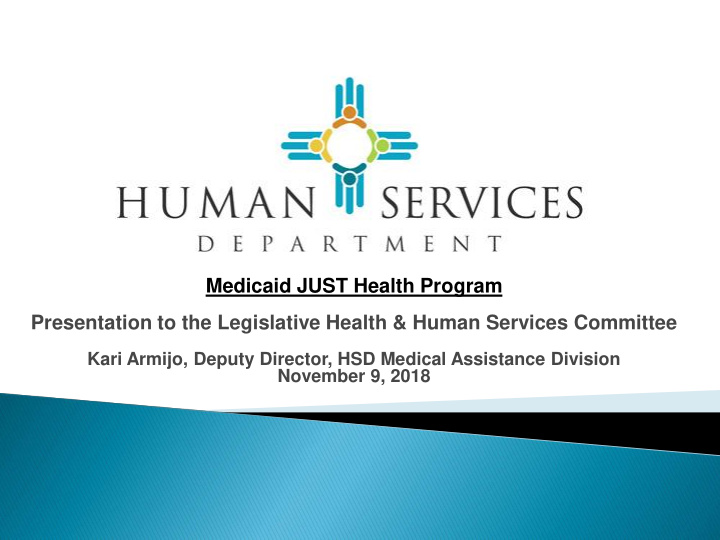



Medicaid JUST Health Program Presentation to the Legislative Health & Human Services Committee Kari Armijo, Deputy Director, HSD Medical Assistance Division November 9, 2018
Medicaid State Plan Amendment for presumptive eligibility – January 2014 Short-Term Medicaid for Incarcerated Individuals (STMII) – implemented with NM Corrections Department in August 2014 State law passed in early 2015; effective 7/1/15 Goal to ensure Medicaid-eligible justice-involved individuals have timely access to health care services when released from prison or jail ◦ Cannot terminate individuals from Medicaid due to incarceration ◦ Must allow individuals to apply for Medicaid while incarcerated ◦ Individuals who qualify for Medicaid retain eligibility upon release for continuity of treatment
Started as a manual process at HSD; was automated in June 2016 Pilot sites selected for rollout of automated process ◦ NM Corrections Department ◦ Metropolitan Detention Center (MDC) ◦ Five additional counties/agencies added in September 2016 ◦ Ongoing phased approach to implementation based on the resources in each county/agency Application Processing Unit established in HSD dedicated to applications from justice-involved individuals
Governmental agreements with each participating facility Participating facilities are required to share daily inmate booking and release information with HSD through a secured interface HSD shares Medicaid eligibility information with the prison/jail daily Benefits are systematically suspended for individuals after 30 days of incarceration Benefits are automatically reactivated when the inmate is released from prison/jail upon receipt of release data from the facility
Implementation has required changes to multiple IT systems: ◦ ASPEN – Medicaid eligibility system ◦ MMIS – Medicaid enrollment and claims information system ◦ Medicaid provider portal – eligibility lookup for providers ◦ HSD system interfaces – allows the systems to “talk” to each other ◦ Prison/jail IT systems – not originally designed to interface with HSD IT systems Extensive testing done with each rollout Added to system maintenance and operations for faster county rollouts going forward
HSD suspends benefits 30 days after incarceration without terminating eligibility Inmate may apply for or recertify Medicaid while incarcerated Inmate is not eligible for Medicaid-covered services and is disenrolled from their managed care organization (MCO) ◦ Exception for short-term inpatient hospital stays – paid under fee-for-service Medicaid (not through a MCO) HSD provides technical assistance and training to facilities so they can facilitate Presumptive Eligibility (PE) and help with the application process
Currently participating counties/agencies: NM Corre recti ction ons Dept. San n Juan n Count nty All facilities, ~7,200 daily population ~563 daily population Bern rnalill llo o Count nty y MDC Sand ndov oval Count nty ~1,489 daily population ~389 daily population NM Child ildre ren, n, Youth th & Famili lies es Dept pt. Sant nta Fe Count nty Juvenile Justice facilities, ~144 daily Adult and juvenile facilities, ~530 population daily population Doña ña Ana Count nty NM Department tment of Health th – Adult and juvenile facilities, ~780 daily Forensi rensics cs Unit it population ~58 daily population Rio o Arri riba Count nty ~140 daily population
August 2014 through September 2018 ◦ 1,541 Presumptive Eligibility determinations ◦ 9,949 ongoing applications filed ◦ 9,231 ongoing applications approved ◦ 22,297 suspensions ◦ 15,527 reinstatements ◦ $5.6 million inpatient hospital claims paid
Centennial Care 2.0 – starts January 1, 2019 ◦ Initiates care coordination for inmates prior to release to establish appointments, referrals, pharmacy access, and continuity of care ◦ Allows for MCO delegation of care coordination to the county or facility ◦ Strengthens MCO contract requirements regarding after-hour transitions to address spontaneous or unplanned discharge from custody/detention ◦ Requires the MCOs to have a dedicated staff position to serve as a liaison to participating facilities – single point-of-contact; facilitate care coordination ◦ Evaluation criteria will track and trend health outcomes for justice- involved members who are actively participating in care coordination
House Bill 19 (2018 Legislative Session) ◦ Requires HSD and the facilities to link inmates in Centennial Care with care coordination prior to release (when allowed by federal waiver) ◦ Requires HSD/BHSD to provide a BH screening tool to county facilities ◦ Requires the exchange of information to facilitate eligibility, suspension and reactivation of benefits JUST Health Workgroup – includes HSD, MCOs, NMCD, CYFD, and counties ◦ Monthly meetings ◦ Mapping a process to facilitate care coordination starting January 1 ◦ Addressing program-specific issues (access to pharmacy, information exchange/lag time, strategies for transition during unplanned release) Inventory of BH screening tools in use by counties Pursuing an interface with APRISS for real-time booking/release data at most facilities
Contact: ◦ Kari Armijo, HSD/MAD Deputy Director – kari.armijo@state.nm.us or (505) 827-1344 ◦ Kathy Slater-Huff, Bureau Chief, HSD/MAD Communication & Education Bureau – katherine.slater-huff@state.nm.us or (505) 476- 7196 ◦ Jeanelle Romero, JUST Health Program Manager – jeanellec.Romero@state.nm.us or (505) 827-7713
Recommend
More recommend